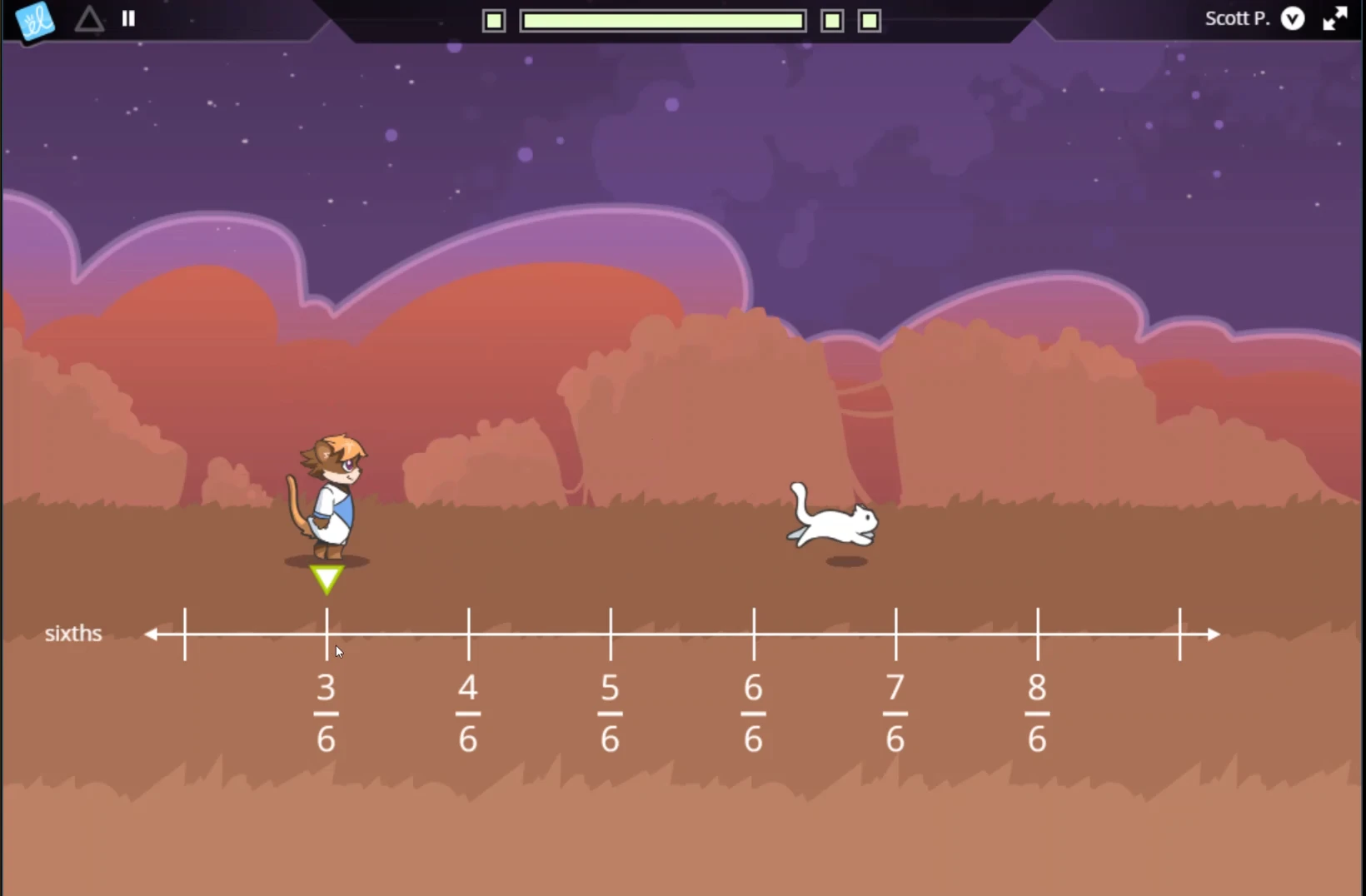
When teaching the basics of fractions, it's easy to spend a lot of time working with fractions like 1/2, 1/6, and 5/6. The danger is that some students may develop the misconception that all fractions are between 0 and 1. But fractions are numbers. And just like any other type of number, fractions can be less than, equal to, or greater than one.
How can you best support students in making sense of fractions greater than 1? Keep reading for practical tips to try today!
What are fractions greater than one?
Fractions are numbers too, and like any number, they can be greater than one. For example, 6/6 on the number line below is equivalent to 1. If you keep counting up by sixths, you get 7/6, 8/6, and beyond. The pattern just keeps going, and all of these are fractions greater than 1.

Students interact with fractions greater than 1 in the game-based fractions program Frax.
Number lines to the rescue
How do you help students move beyond 1? Lean on number lines! If students can already picture fractions as numbers on the number line, they will be much more ready to make that leap (mentally and physically) to conceptually understand fractions greater than one.
Why are fractions greater than one important?
Fractions greater than one are important because students will encounter them on number lines, when comparing fractions, working with equivalent fractions, and performing fraction arithmetic. Students will also interact with fractions greater than one in everyday life.
Common teaching challenges
If students only understand fractions as “parts of a whole” rather than numbers themselves, they will likely be confused with the concept of fractions greater than one since it’s hard to imagine something “more than a whole.” For example, if students visualize 8/8 as a “whole” pizza, it’s difficult to picture 9/8 as a fraction since the circular model only accounts for 8 slices.
You might also encounter the term improper fractions in textbooks or curricula to describe a fraction with a greater numerator than the denominator. It’s important to address this term with students (in case they encounter it on an assessment), but there is no need to emphasize it during instruction because once students understand that fractions are numbers, it becomes much more intuitive that numbers (including fractions) can be greater than one. A fraction is still a fraction whether it is less than, equal to, or greater than one.
Effective teaching strategies for fractions greater than one
To help students understand fractions greater than one, they must first firmly grasp fractions as numbers. When teaching fractions, help your class see how each fraction has a specific magnitude (size) and position on the number line alongside whole numbers and other fractions. You can do this using physical manipulatives, engaging digital resources, dominoes, or even food!
Students must understand how a numerator and denominator work together to create a single value (length). When students work with fractions on the number line, they gain practice determining the value of each interval, which assists them in future work with fractions greater than one.
In the example below from ExploreLearning Frax, students move forward on the number line after recognizing that each interval represents 1/2. They start at 5/2 and add 4/2, as shown in the animation. Students ultimately land on 9/2, a fraction greater than 1.

Students can practice rewriting fractions greater than 1 as mixed numbers (an integer and a fraction). For example, 11/9 can be expressed as the mixed number 1 2/9.

Teach fractions with Frax
Frax is an adaptive and individualized fractions solution that naturally introduces students to fractions greater than one. Grounded in evidence-based research, Frax’s zero-entry program allows all students to develop a foundational understanding of fractions while receiving in-the-moment feedback tailored to their level of understanding.
From day one of Frax, students work with fractions as numbers in intuitive settings. As students complete carefully scaffolded game-based practice, they naturally progress from block model representations to number lines as they develop a strong understanding of fraction magnitude. This intuitive progression helps students easily make sense of fractions greater than one.
“The students LOVE using Frax. It is very engaging! They are showing a deeper understanding of fractions greater than one and equivalent fractions.”
-Grade 3 teacher. Wrentham Public Schools, MA
For example, in the Boogie Bots Frax game, students translate fractions into their whole number equivalents using block models as support.
“Students understand fractions greater than one much better with Frax.”
-Grade 4 teacher. Anna Elementary School, OH.
Teachers trust Frax
Frax uses brief, just-in-time instruction and adaptive questioning to help students learn by doing and master their understanding of fractions as numbers. Frax also provides real-time reporting to monitor student progress. Teachers are also notified when students are struggling so they can quickly intervene to provide help or clarification.
A detailed Teacher Guide and a robust collection of engaging Frax offline activities provide teachers with the tools to reinforce concepts, extend learning, and assess understanding.
Research shows Frax gives all students the ability to master fractions, increasing math performance, building math confidence, and laying the foundation for ongoing success in math. Get started with Frax today with a free classroom trial!
“Frax is by far the best tool I have used to teach fractions. I have been sharing the progress with my administrative team, and they are blown away by the growth shown in my students. Students are picking up things I have been trying to get them to understand for a long time without added stress (like how a fraction can be greater than one). They are obtaining the foundational skills necessary to be successful with fractions. Students have said they feel successful and are no longer afraid of fractions because of Frax.”
-Grade 5 teacher. San Elizario Independent School District, TX
